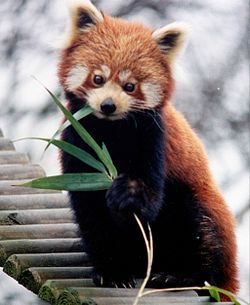レッサーパンダ科
| レッサーパンダ | |||||||||||||||||||||||||||||||||
|---|---|---|---|---|---|---|---|---|---|---|---|---|---|---|---|---|---|---|---|---|---|---|---|---|---|---|---|---|---|---|---|---|---|

| |||||||||||||||||||||||||||||||||
| |||||||||||||||||||||||||||||||||
| familia Ailuridae Gray, 1843 [1] | |||||||||||||||||||||||||||||||||
| タイプ | |||||||||||||||||||||||||||||||||
| Ailurus F.Cuvier, 1825 | |||||||||||||||||||||||||||||||||
|
レッサーパンダ
分類 の歴史
[フレデリック・キュヴィエが
レッサーパンダは
下位 分類
[レッサーパンダ
- Ailuridae レッサーパンダ
科 (アイルルス科 )- ? †Amphictis アンフィクティス(アムピクティス)
属 - †Protursus プロトゥルスス
属 - Ailurinae レッサーパンダ
亜 科 (アイルルス亜 科 )- †Magerictis マゲリクティス
属 - †Parailurus パライルルス(パルアイルルス)
属 - †Pristinailurus プリスティナイルルス(プリスティンアイルルス)
属 - Ailurus レッサーパンダ
属 (アイルルス属 ) Red panda
- †Magerictis マゲリクティス
- †Simocyoninae シモキオン
亜 科 - †Actiocyon アクティオキオン
属 - †Alopecocyon アロペコキオン
属 - †Simocyon シモキオン
属
- †Actiocyon アクティオキオン
- ? †Amphictis アンフィクティス(アムピクティス)
脚注 ・出典
[- ^ Ailuridae Gray, 1843 - ITIS
- ^ フレデリック・キュヴィエ (1825). “PANDA.”.
哺乳類 の自然 史 . - ^ a b c Mayr, E (1986). “Uncertainty in Science: is the Giant Panda a Bear or a Raccoon?”. Nature 323: 769–771. doi:10.1038/323769a0.
- ^ Zhang, YP & Ryder, OA (1993). “Mitochondrial DNA sequence evolution in the Arctoidea”. Proc. Natl. Acad. Sci. 90: 9557–9561. doi:10.1073/pnas.90.20.9557. PMID 8415740.
- ^ Slattery JP & O'Brien, SJ (1995). “Molecular phylogeny of the red panda (Ailurus fulgens)”. J. Hered. 86: 413–422.
- ^ Su, Bing, Yunxin Fu, Yingxiang Wang, Li Jin and Ranajit Chakraborty (2001). “Genetic Diversity and Population History of the Red Panda (Ailurus fulgens) as Inferred from Mitochondrial DNA Sequence Variations”. Molecular Biology and Evolution 18: 1070–1076.
- ^ Li, WH (1997). Molecular Evolution. Sunderland, MA: Sinauer
- ^ “Whence the Red Panda” (PDF). 2007
年 2月 25日 閲覧 。 - ^ Roberts, MS & Gittleman, JL (1984). “Ailurus fulgens”. Mammalian Species 222: 1–8. doi:10.2307/3503840.
- ^ McKenna, MC & Bell SK (1997). Classification of Mammals Above the Species Level. Columbia University Press
- ^ Peigné, S., M. Salesa, M. Antón, and J. Morales (2005). “Ailurid carnivoran mammal Simocyon from the late Miocene of Spain and the systematics of the genus”. Acta Palaeontologica Polonica 50: 219–238.
- ^ Salesa, M., M. Antón, S. Peigné, and J. Morales (2006). “Evidence of a false thumb in a fossil carnivore clarifies the evolution of pandas”. Proceedings of the National Academy of Sciences 103: 379–382. doi:10.1073/pnas.0504899102. PMID 16387860.
- ^ Wallace, SC & Wang, X (2004). “Two new carnivores from an unusual late Tertiary forest biota in eastern North America”. Nature 431: 556–559. doi:10.1038/nature02819.
- ^ Carnivoran Evolution. Cambridge University Press. (2010
年 7月 29日 )
- Davis, Davis D. (1964). “The Giant Panda: A Morphological Study of Evolutionary Mechanisms.“ Zoology Memoirs. Vol. 3:1-339.
- Decker D.M. and W.C. Wozencraft. (1991). “Phylogenetic Analysis of Recent Procyonid Genera.“ Journal of Mammalogy. Vol. 72 (1): 42-55.
- Flynn, J.J. and G.D. Wesley Hunt. (2005a). “Carnivora.“ in The Rise of Placental Mammals: Origin, Timing and Relationships of the Major Extant Clades, by D. Archibold and K. Rose. Baltimore. ISBN 080188022X
- Flynn, John J., et al. (2005b). “Molecular phylogeny of the Carnivora (Mammalia): ASS-ASS the impact of increased sampling to on resolving enigmatic relationships.“ Systematic Biology. Vol. 54 (2):1-21. [1] (PDF)
- Flynn, John J. Flynn, Michael A. Nedbal, J.W. Dragoo, and R.L. Honeycutt. (1998) "Whence the Red Panda?" Molecular Phylogenetics and Evolution. Vol. 17, No. 2, November 2000, pp. 190–199. [2] (PDF)
- Glatston, A.R. (1989). Talk Panda Biology. The Hague. ISBN 9-051-03026-6
- Glatston, A.R. (compiler) (1994). “The Red Panda, Olingos, Coatis, Raccoons, and their Relatives: Status survey and conservation action plan for Procyonids and Ailurids.”
- IUCN/SSC Mustelid, Viverrid, and Procyonid Specialist Group. IUCN/SSC, Gland, Switzerland.
- Gregory, W.K. (1936). “On the Phylogenetic Relationships of the Giant Panda (Ailuropoda) to other Arctoid Carnivores.“ American Museum Novitates. Vol. 878:1-29.
- Hu, J.C. (1990). “Proceedings of studies of the red panda.” Chinese Scientific Publishing, Beijing, China [in Chinese].
- Wilson, Don E. and DeeAnn M. Reeder. (2005). Mammal of Species of the World. Johns Hopkins University press. ISBN 0801882214.
